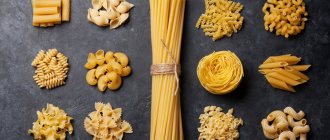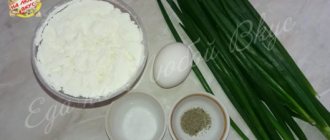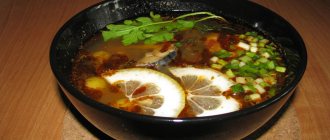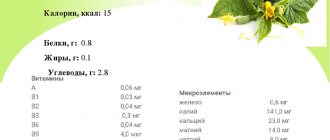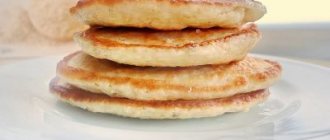Composition and calorie content of pasta:
So, what does 100 grams of dry pasta contain?
Proteins, fats, carbohydrates and calories per 100 grams of pasta:
- Proteins - 9-11 g;
- Fats - 1-5 g;
- Carbohydrates - 70-75 g;
- The total calories in pasta are 350 Kcal.
Usually the calorie content is calculated from the mass of the dry product, but if this is not possible, then the calorie content of boiled pasta per 100 grams is 110-120 Kcal.
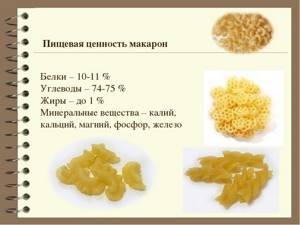
Vitamins in pasta and their percentage of daily value:
- E (tocopherol) - 1.5 mg (6%);
- B1 (thiamine) - 0.17 mg (10%);
- B2 (riboflavin) - 0.04 mg (2%);
- B3(PP) (niacin) - 1.2 mg (8%);
- B4 (choline) - 52.5 mg (15%);
- B5 (pantothenic acid) - 0.3 mg (4%);
- B6 (pyridoxine) - 0.16 mg (7%);
- B9 (folic acid) - 0.02 mg (8%).
Micro and Macroelements:
- Potassium - 123 mg (5%);
- Calcium - 19 mg (2%);
- Magnesium - 16 mg (4%);
- Sodium - 3 mg (0.5%);
- Sulfur - 0.07 mg (7%);
- Phosphorus - 87 mg (10%);
- Chlorine - 77 mg (1%);
- Iron - 1.6 mg (10%);
- Iodine - 1.5 mcg (1%);
- Manganese - 0.6 mg (25%);
- Copper - 0.7 mg (25%);
- Molybdenum - 13 mcg (27%);
- Fluoride - 23 mcg (1%);
- Chromium - 2 mcg (1%);
- Zinc - 0.7 mg (5%).
Recipe for Pasta with minced meat. Calorie, chemical composition and nutritional value.
Nutritional value and chemical composition of “Pasta with minced meat”.
The table shows the nutritional content (calories, proteins, fats, carbohydrates, vitamins and minerals) per 100 grams of edible portion.
| Nutrient | Quantity | Norm** | % of the norm in 100 g | % of the norm in 100 kcal | 100% normal |
| Calorie content | 146 kcal | 1684 kcal | 8.7% | 6% | 1153 g |
| Squirrels | 12.2 g | 76 g | 16.1% | 11% | 623 g |
| Fats | 4.8 g | 56 g | 8.6% | 5.9% | 1167 g |
| Carbohydrates | 13.5 g | 219 g | 6.2% | 4.2% | 1622 g |
| Organic acids | 0.1 g | ~ | |||
| Alimentary fiber | 0.7 g | 20 g | 3.5% | 2.4% | 2857 g |
| Water | 67.2 g | 2273 g | 3% | 2.1% | 3382 g |
| Ash | 1.472 g | ~ | |||
| Vitamins | |||||
| Vitamin A, RE | 24 mcg | 900 mcg | 2.7% | 1.8% | 3750 g |
| Retinol | 0.021 mg | ~ | |||
| beta carotene | 0.029 mg | 5 mg | 0.6% | 0.4% | 17241 g |
| Lycopene | 693.218 mcg | ~ | |||
| Lutein + Zeaxanthin | 9.253 mcg | ~ | |||
| Vitamin B1, thiamine | 0.126 mg | 1.5 mg | 8.4% | 5.8% | 1190 g |
| Vitamin B2, riboflavin | 0.169 mg | 1.8 mg | 9.4% | 6.4% | 1065 g |
| Vitamin B4, choline | 27.6 mg | 500 mg | 5.5% | 3.8% | 1812 |
| Vitamin B5, pantothenic | 0.28 mg | 5 mg | 5.6% | 3.8% | 1786 |
| Vitamin B6, pyridoxine | 0.167 mg | 2 mg | 8.4% | 5.8% | 1198 g |
| Vitamin B9, folates | 3.138 mcg | 400 mcg | 0.8% | 0.5% | 12747 g |
| Vitamin B12, cobalamin | 0.225 mcg | 3 mcg | 7.5% | 5.1% | 1333 g |
| Vitamin C, ascorbic acid | 0.32 mg | 90 mg | 0.4% | 0.3% | 28125 g |
| Vitamin D, calciferol | 0.148 mcg | 10 mcg | 1.5% | 1% | 6757 g |
| Vitamin D3, cholecalciferol | 0.046 mcg | ~ | |||
| Vitamin E, alpha tocopherol, TE | 0.518 mg | 15 mg | 3.5% | 2.4% | 2896 g |
| gamma tocopherol | 0.014 mg | ~ | |||
| Vitamin H, biotin | 0.497 mcg | 50 mcg | 1% | 0.7% | 10060 g |
| Vitamin K, phylloquinone | 0.4 mcg | 120 mcg | 0.3% | 0.2% | 30000 g |
| Vitamin RR, NE | 3.7521 mg | 20 mg | 18.8% | 12.9% | 533 g |
| Niacin | 0.257 mg | ~ | |||
| Betaine | 2.195 mg | ~ | |||
| Macronutrients | |||||
| Potassium, K | 153.51 mg | 2500 mg | 6.1% | 4.2% | 1629 g |
| Calcium, Ca | 106.03 mg | 1000 mg | 10.6% | 7.3% | 943 g |
| Magnesium, Mg | 14.49 mg | 400 mg | 3.6% | 2.5% | 2761 g |
| Sodium, Na | 318.91 mg | 1300 mg | 24.5% | 16.8% | 408 g |
| Sera, S | 101.72 mg | 1000 mg | 10.2% | 7% | 983 g |
| Phosphorus, P | 171.8 mg | 800 mg | 21.5% | 14.7% | 466 g |
| Chlorine, Cl | 223.31 mg | 2300 mg | 9.7% | 6.6% | 1030 g |
| Microelements | |||||
| Iron, Fe | 0.73 mg | 18 mg | 4.1% | 2.8% | 2466 g |
| Manganese, Mn | 0.0106 mg | 2 mg | 0.5% | 0.3% | 18868 |
| Copper, Cu | 22.13 mcg | 1000 mcg | 2.2% | 1.5% | 4519 g |
| Selenium, Se | 12.886 mcg | 55 mcg | 23.4% | 16% | 427 g |
| Fluorine, F | 5.7 mcg | 4000 mcg | 0.1% | 0.1% | 70175 g |
| Zinc, Zn | 1.019 mg | 12 mg | 8.5% | 5.8% | 1178 g |
| Digestible carbohydrates | |||||
| Starch and dextrins | 11.12 g | ~ | |||
| Mono- and disaccharides (sugars) | 1.9 g | max 100 g | |||
| Glucose (dextrose) | 0.589 g | ~ | |||
| Sucrose | 0.132 g | ~ | |||
| Fructose | 0.501 g | ~ | |||
| Essential amino acids | 1.052 g | ~ | |||
| Arginine* | 0.549 g | ~ | |||
| Valin | 0.533 g | ~ | |||
| Histidine* | 0.444 g | ~ | |||
| Isoleucine | 0.448 g | ~ | |||
| Leucine | 0.833 g | ~ | |||
| Lysine | 0.781 g | ~ | |||
| Methionine | 0.264 g | ~ | |||
| Threonine | 0.425 g | ~ | |||
| Tryptophan | 0.163 g | ~ | |||
| Phenylalanine | 0.426 g | ~ | |||
| Nonessential amino acids | 1.841 g | ~ | |||
| Alanin | 0.493 g | ~ | |||
| Aspartic acid | 0.871 g | ~ | |||
| Hydroxyproline | 0.068 g | ~ | |||
| Glycine | 0.449 g | ~ | |||
| Glutamic acid | 1.58 g | ~ | |||
| Proline | 0.651 g | ~ | |||
| Serin | 0.666 g | ~ | |||
| Tyrosine | 0.439 g | ~ | |||
| Cysteine | 0.108 g | ~ | |||
| Sterols (sterols) | |||||
| Cholesterol | 28.64 mg | max 300 mg | |||
| Fatty acid | |||||
| Trans fats | 0.016 g | max 1.9 g | |||
| monounsaturated trans fats | 0.011 g | ~ | |||
| Saturated fatty acids | |||||
| Saturated fatty acids | 2 g | max 18.7 g | |||
| 8:0 Caprylic | 0.026 g | ~ | |||
| 10:0 Kaprinovaya | 0.094 g | ~ | |||
| 12:0 Lauric | 0.107 g | ~ | |||
| 14:0 Miristinovaya | 0.314 g | ~ | |||
| 15:0 Pentadecane | 0.04 g | ~ | |||
| 16:0 Palmitinaya | 1.056 g | ~ | |||
| 17:0 Margarine | 0.03 g | ~ | |||
| 18:0 Stearic | 0.523 g | ~ | |||
| 20:0 Arakhinovaya | 0.047 g | ~ | |||
| Monounsaturated fatty acids | 1.572 g | min 16.8 g | 9.4% | 6.4% | |
| 14:1 Myristoleic | 0.052 g | ~ | |||
| 16:1 Palmitoleic | 0.112 g | ~ | |||
| 18:1 Oleic (omega-9) | 1.394 g | ~ | |||
| 18:1 cis | 0.485 g | ~ | |||
| 18:1 trans | 0.011 g | ~ | |||
| 20:1 Gadoleic (omega-9) | 0.014 g | ~ | |||
| Polyunsaturated fatty acids | 0.28 g | from 11.2 to 20.6 g | 2.5% | 1.7% | |
| 18:2 Linolevaya | 0.252 g | ~ | |||
| 18:2 Omega-6, cis, cis | 0.153 g | ~ | |||
| 18:2 trance, trance | 0.005 g | ~ | |||
| 18:3 Linolenic | 0.006 g | ~ | |||
| 18:3 Omega-3, alpha-linolenic | 0.006 g | ~ | |||
| 20:2 Eicosadiene, Omega-6, cis, cis | 0.007 g | ~ | |||
| 20:4 Arachidonic | 0.019 g | ~ | |||
| 22:5 Docosapentaenoic acid (DPA), Omega-3 | 0.002 g | ~ | |||
| 22:6 Docosahexaenoic acid (DHA), Omega-3 | 0.001 g | ~ | |||
| Omega-6 fatty acids | 0.3 g | from 4.7 to 16.8 g | 6.4% | 4.4% |
The energy value of Pasta with minced meat is 146 kcal.
Primary Source: Created in the application by the user. Read more.
** This table shows the average levels of vitamins and minerals for an adult. If you want to know the norms taking into account your gender, age and other factors, then use the “My Healthy Diet” application.
Spelled pasta: benefits and harms
Spelled is a type of wheat. Spelled flour is used to make pasta and various baked goods.
Spelled pasta has a calorie content per 100 grams = 340 Kcal
- Proteins = 15 g;
- Fats = 2 g;
- Carbohydrates = 61 g.

Pros (benefits of pasta):
- This product, as a representative of carbohydrates, has a relatively low glycemic index, which means it is approved for consumption by people suffering from diabetes.
- Has the ability to remove bad cholesterol.
- Improves brain activity.
- Cleansing the skin.
Cons (harmful pasta):
There are individual contraindications: allergic reaction, indigestion, individual intolerance. In general, there is practically no harm to pasta. Separately, it’s just flour, water, possibly (but not necessarily) eggs, milk, soy.
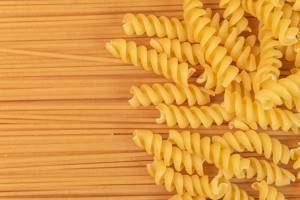
Recipe for pasta with beef. Calorie, chemical composition and nutritional value.
Nutritional value and chemical composition of “Beef Pasta”.
The table shows the nutritional content (calories, proteins, fats, carbohydrates, vitamins and minerals) per 100 grams of edible portion.
| Nutrient | Quantity | Norm** | % of the norm in 100 g | % of the norm in 100 kcal | 100% normal |
| Calorie content | 158.4 kcal | 1684 kcal | 9.4% | 5.9% | 1063 g |
| Squirrels | 8.7 g | 76 g | 11.4% | 7.2% | 874 g |
| Fats | 5 g | 56 g | 8.9% | 5.6% | 1120 g |
| Carbohydrates | 19.3 g | 219 g | 8.8% | 5.6% | 1135 g |
| Alimentary fiber | 1.3 g | 20 g | 6.5% | 4.1% | 1538 g |
| Water | 48 g | 2273 g | 2.1% | 1.3% | 4735 g |
| Ash | 0.8737 g | ~ | |||
| Vitamins | |||||
| Vitamin A, RE | 55.8 mcg | 900 mcg | 6.2% | 3.9% | 1613 g |
| alpha carotene | 0.397 mcg | ~ | |||
| beta carotene | 0.341 mg | 5 mg | 6.8% | 4.3% | 1466 g |
| beta Cryptoxanthin | 0.0657 mcg | ~ | |||
| Lycopene | 393.7462 mcg | ~ | |||
| Lutein + Zeaxanthin | 4.2579 mcg | ~ | |||
| Vitamin B1, thiamine | 0.035 mg | 1.5 mg | 2.3% | 1.5% | 4286 g |
| Vitamin B2, riboflavin | 0.072 mg | 1.8 mg | 4% | 2.5% | 2500 g |
| Vitamin B4, choline | 24.17 mg | 500 mg | 4.8% | 3% | 2069 g |
| Vitamin B5, pantothenic | 0.218 mg | 5 mg | 4.4% | 2.8% | 2294 g |
| Vitamin B6, pyridoxine | 0.152 mg | 2 mg | 7.6% | 4.8% | 1316 g |
| Vitamin B9, folates | 7.357 mcg | 400 mcg | 1.8% | 1.1% | 5437 g |
| Vitamin B12, cobalamin | 0.712 mcg | 3 mcg | 23.7% | 15% | 421 g |
| Vitamin C, ascorbic acid | 0.76 mg | 90 mg | 0.8% | 0.5% | 11842 g |
| Vitamin E, alpha tocopherol, TE | 0.301 mg | 15 mg | 2% | 1.3% | 4983 g |
| beta tocopherol | 0.017 mg | ~ | |||
| gamma tocopherol | 0.2975 mg | ~ | |||
| delta tocopherol | 0.0001 mg | ~ | |||
| Vitamin H, biotin | 0.898 mcg | 50 mcg | 1.8% | 1.1% | 5568 g |
| Vitamin K, phylloquinone | 0.7 mcg | 120 mcg | 0.6% | 0.4% | 17143 g |
| Dihydrophylloquinone | 0.2841 mcg | ~ | |||
| Vitamin RR, NE | 2.5041 mg | 20 mg | 12.5% | 7.9% | 799 g |
| Niacin | 1.347 mg | ~ | |||
| Betaine | 38.654 mg | ~ | |||
| Macronutrients | |||||
| Potassium, K | 142.56 mg | 2500 mg | 5.7% | 3.6% | 1754 g |
| Calcium, Ca | 12.46 mg | 1000 mg | 1.2% | 0.8% | 8026 g |
| Silicon, Si | 0.096 mg | 30 mg | 0.3% | 0.2% | 31250 g |
| Magnesium, Mg | 19.15 mg | 400 mg | 4.8% | 3% | 2089 g |
| Sodium, Na | 266.35 mg | 1300 mg | 20.5% | 12.9% | 488 g |
| Sera, S | 66.95 mg | 1000 mg | 6.7% | 4.2% | 1494 g |
| Phosphorus, P | 91.1 mg | 800 mg | 11.4% | 7.2% | 878 g |
| Chlorine, Cl | 381.62 mg | 2300 mg | 16.6% | 10.5% | 603 g |
| Microelements | |||||
| Aluminium, Al | 35.4 mcg | ~ | |||
| Bor, B | 6.2 mcg | ~ | |||
| Vanadium, V | 1.37 mcg | ~ | |||
| Iron, Fe | 1.231 mg | 18 mg | 6.8% | 4.3% | 1462 g |
| Yod, I | 2.1 mcg | 150 mcg | 1.4% | 0.9% | 7143 g |
| Cobalt, Co | 2.188 mcg | 10 mcg | 21.9% | 13.8% | 457 g |
| Lithium, Li | 0.164 mcg | ~ | |||
| Manganese, Mn | 0.2248 mg | 2 mg | 11.2% | 7.1% | 890 g |
| Copper, Cu | 119.37 mcg | 1000 mcg | 11.9% | 7.5% | 838 g |
| Molybdenum, Mo | 4.039 mcg | 70 mcg | 5.8% | 3.7% | 1733 g |
| Nickel, Ni | 2.5 mcg | ~ | |||
| Tin, Sn | 20.82 mcg | ~ | |||
| Rubidium, Rb | 13 mcg | ~ | |||
| Selenium, Se | 15.205 mcg | 55 mcg | 27.6% | 17.4% | 362 g |
| Strontium, Sr | 0.16 mcg | ~ | |||
| Titanium, Ti | 0.19 mcg | ~ | |||
| Fluorine, F | 25.01 mcg | 4000 mcg | 0.6% | 0.4% | 15994 g |
| Chromium, Cr | 2.33 mcg | 50 mcg | 4.7% | 3% | 2146 g |
| Zinc, Zn | 1.2281 mg | 12 mg | 10.2% | 6.4% | 977 g |
| Zirconium, Zr | 0.02 mcg | ~ | |||
| Digestible carbohydrates | |||||
| Starch and dextrins | 15.81 g | ~ | |||
| Mono- and disaccharides (sugars) | 0.9 g | max 100 g | |||
| Glucose (dextrose) | 0.2055 g | ~ | |||
| Maltose | 0.2311 g | ~ | |||
| Sucrose | 0.329 g | ~ | |||
| Fructose | 0.1573 g | ~ | |||
| Essential amino acids | 0.0164 g | ~ | |||
| Arginine* | 0.1268 g | ~ | |||
| Valin | 0.1519 g | ~ | |||
| Histidine* | 0.0768 g | ~ | |||
| Isoleucine | 0.1328 g | ~ | |||
| Leucine | 0.2543 g | ~ | |||
| Lysine | 0.0801 g | ~ | |||
| Methionine | 0.0378 g | ~ | |||
| Methionine + Cysteine | 0.0011 g | ~ | |||
| Threonine | 0.1208 g | ~ | |||
| Tryptophan | 0.0484 g | ~ | |||
| Phenylalanine | 0.1725 g | ~ | |||
| Phenylalanine+Tyrosine | 0.0033 g | ~ | |||
| Nonessential amino acids | 0.0344 g | ~ | |||
| Alanin | 0.1155 g | ~ | |||
| Aspartic acid | 0.1726 g | ~ | |||
| Glycine | 0.1146 g | ~ | |||
| Glutamic acid | 1.2038 g | ~ | |||
| Proline | 0.3993 g | ~ | |||
| Serin | 0.1596 g | ~ | |||
| Tyrosine | 0.0636 g | ~ | |||
| Cysteine | 0.0655 g | ~ | |||
| Sterols (sterols) | |||||
| Phytosterols | 0.1259 mg | ~ | |||
| Saturated fatty acids | |||||
| Saturated fatty acids | 0.1 g | max 18.7 g | |||
| 12:0 Lauric | 0.0035 g | ~ | |||
| 14:0 Miristinovaya | 0.0035 g | ~ | |||
| 16:0 Palmitinaya | 0.087 g | ~ | |||
| 18:0 Stearic | 0.0082 g | ~ | |||
| Monounsaturated fatty acids | 0.0767 g | min 16.8 g | 0.5% | 0.3% | |
| 18:1 Oleic (omega-9) | 0.0767 g | ~ | |||
| 18:1 cis | 0.0744 g | ~ | |||
| Polyunsaturated fatty acids | 0.185 g | from 11.2 to 20.6 g | 1.7% | 1.1% | |
| 18:2 Linolevaya | 0.171 g | ~ | |||
| 18:3 Linolenic | 0.0139 g | ~ | |||
| 18:3 Omega-3, alpha-linolenic | 0.0136 g | ~ | |||
| Omega-6 fatty acids | 0.2 g | from 4.7 to 16.8 g | 4.3% | 2.7% |
The energy value of Pasta with beef is 158.4 kcal.
Primary Source: Created in the application by the user. Read more.
** This table shows the average levels of vitamins and minerals for an adult. If you want to know the norms taking into account your gender, age and other factors, then use the “My Healthy Diet” application.
Shelf life of pasta:
Now let's talk about how long raw and cooked pasta is stored. Each pasta has a shelf life. Here it is important to know what raw materials the pasta is made from. If the composition contains only flour and water, then such raw pasta can be stored for up to 3 years. If there is egg white, the period is reduced to 1 year, and if the composition contains soy or dairy products - only 5 months. Although the shelf life of colored pasta can reach 3 years. Provided that they are stored at room temperature not exceeding 25°C, with air humidity not exceeding 70%. To the question why pasta should be stored in a dry place, there is a completely logical answer: the less humid the environment, the less likely it is that various flora will form on the pasta, using it as a source of life.

As for already cooked pasta, the period here is reduced several times. To tell exactly how long finished pasta can be stored, you need to create optimal conditions for it. When stored in the refrigerator, the shelf life of cooked pasta can be up to 5 days. If you cook them together with various sauces, the shelf life is reduced to 2 days.
Recipe for Pasta with meat. Calorie, chemical composition and nutritional value.
Nutritional value and chemical composition of “Pasta with meat”.
The table shows the nutritional content (calories, proteins, fats, carbohydrates, vitamins and minerals) per 100 grams of edible portion.
| Nutrient | Quantity | Norm** | % of the norm in 100 g | % of the norm in 100 kcal | 100% normal |
| Calorie content | 126.1 kcal | 1684 kcal | 7.5% | 5.9% | 1335 g |
| Squirrels | 5 g | 76 g | 6.6% | 5.2% | 1520 g |
| Fats | 9.7 g | 56 g | 17.3% | 13.7% | 577 g |
| Carbohydrates | 4.7 g | 219 g | 2.1% | 1.7% | 4660 g |
| Organic acids | 0.1 g | ~ | |||
| Alimentary fiber | 1 g | 20 g | 5% | 4% | 2000 g |
| Water | 80 g | 2273 g | 3.5% | 2.8% | 2841 g |
| Vitamins | |||||
| Vitamin A, RE | 498.2 mcg | 900 mcg | 55.4% | 43.9% | 181 g |
| beta carotene | 2.99 mg | 5 mg | 59.8% | 47.4% | 167 g |
| Vitamin B1, thiamine | 0.155 mg | 1.5 mg | 10.3% | 8.2% | 968 g |
| Vitamin B2, riboflavin | 0.061 mg | 1.8 mg | 3.4% | 2.7% | 2951 g |
| Vitamin B4, choline | 23.21 mg | 500 mg | 4.6% | 3.6% | 2154 g |
| Vitamin B5, pantothenic | 0.251 mg | 5 mg | 5% | 4% | 1992 |
| Vitamin B6, pyridoxine | 0.137 mg | 2 mg | 6.9% | 5.5% | 1460 g |
| Vitamin B9, folates | 5.99 mcg | 400 mcg | 1.5% | 1.2% | 6678 g |
| Vitamin B12, cobalamin | 0.603 mcg | 3 mcg | 20.1% | 15.9% | 498 g |
| Vitamin C, ascorbic acid | 1.25 mg | 90 mg | 1.4% | 1.1% | 7200 g |
| Vitamin E, alpha tocopherol, TE | 0.324 mg | 15 mg | 2.2% | 1.7% | 4630 g |
| Vitamin H, biotin | 1.078 mcg | 50 mcg | 2.2% | 1.7% | 4638 g |
| Vitamin K, phylloquinone | 7.4 mcg | 120 mcg | 6.2% | 4.9% | 1622 g |
| Vitamin RR, NE | 2.1664 mg | 20 mg | 10.8% | 8.6% | 923 g |
| Macronutrients | |||||
| Potassium, K | 155.37 mg | 2500 mg | 6.2% | 4.9% | 1609 g |
| Calcium, Ca | 24 mg | 1000 mg | 2.4% | 1.9% | 4167 g |
| Silicon, Si | 0.15 mg | 30 mg | 0.5% | 0.4% | 20000 g |
| Magnesium, Mg | 20.68 mg | 400 mg | 5.2% | 4.1% | 1934 |
| Sodium, Na | 502.41 mg | 1300 mg | 38.6% | 30.6% | 259 g |
| Sera, S | 81.73 mg | 1000 mg | 8.2% | 6.5% | 1224 g |
| Phosphorus, Ph | 69 mg | 800 mg | 8.6% | 6.8% | 1159 g |
| Chlorine, Cl | 777.57 mg | 2300 mg | 33.8% | 26.8% | 296 g |
| Microelements | |||||
| Bor, B | 70.7 mcg | ~ | |||
| Vanadium, V | 25.94 mcg | ~ | |||
| Iron, Fe | 1.103 mg | 18 mg | 6.1% | 4.8% | 1632 g |
| Yod, I | 3.75 mcg | 150 mcg | 2.5% | 2% | 4000 g |
| Cobalt, Co | 3.337 mcg | 10 mcg | 33.4% | 26.5% | 300 g |
| Manganese, Mn | 0.1451 mg | 2 mg | 7.3% | 5.8% | 1378 g |
| Copper, Cu | 124.95 mcg | 1000 mcg | 12.5% | 9.9% | 800 g |
| Molybdenum, Mo | 10.69 mcg | 70 mcg | 15.3% | 12.1% | 655 g |
| Selenium, Se | 0.043 mcg | 55 mcg | 0.1% | 0.1% | 127907 g |
| Fluorine, F | 73.25 mcg | 4000 mcg | 1.8% | 1.4% | 5461 g |
| Chromium, Cr | 4.07 mcg | 50 mcg | 8.1% | 6.4% | 1229 g |
| Zinc, Zn | 1.1448 mg | 12 mg | 9.5% | 7.5% | 1048 g |
| Sterols (sterols) | |||||
| Cholesterol | 21.1 mg | max 300 mg |
The energy value of Pasta with meat is 126.1 kcal.
Primary Source: Created in the application by the user. Read more.
** This table shows the average levels of vitamins and minerals for an adult. If you want to know the norms taking into account your gender, age and other factors, then use the “My Healthy Diet” application.
health-diet.ru
Calorie content of Navy pasta with beef. Chemical composition and nutritional value.
Chemical composition and nutritional analysis
Nutritional value and chemical composition of “Fleet-style pasta with beef.”
The table shows the nutritional content (calories, proteins, fats, carbohydrates, vitamins and minerals) per 100 grams of edible portion.
| Nutrient | Quantity | Norm** | % of the norm in 100 g | % of the norm in 100 kcal | 100% normal |
| Calorie content | 159.3 kcal | 1684 kcal | 9.5% | 6% | 1057 g |
| Squirrels | 8.5 g | 76 g | 11.2% | 7% | 894 g |
| Fats | 7.1 g | 56 g | 12.7% | 8% | 789 g |
| Carbohydrates | 15.2 g | 219 g | 6.9% | 4.3% | 1441 g |
The energy value of Navy Pasta with beef is 159.3 kcal.
Primary Source: Created in the application by the user. Read more.
** This table shows the average levels of vitamins and minerals for an adult. If you want to know the norms taking into account your gender, age and other factors, then use the “My Healthy Diet” application.
